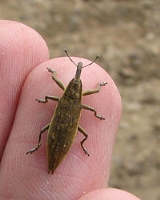
Lixinae
Encyclopedia
Lixinae is a subfamily of true weevils, included in the Molytinae
in many older treatments. They are mainly root feeders, although some develop in flower buds or stems. Several species
are used in biological control of invasive weeds, namely knapweeds (Centaurea).
Characteristics include tarsal claws that are fused at the base, and labial palps are short and telescoping. The body is elongate shape, as for some other weevils. Each tibia bears an uncus (small hook) on its distal end. The rostrum
is forwardly directed.
There are three tribe
s. The largest of these by far are the Cleonini, sometimes ranked as an independent subfamily in the past:
Cleonini
Lixini
Rhinocyllini
Molytinae
Molytinae is a subfamily of weevil described by Carl Johan Schönherr in 1823.Molytinae includes the following tribes:* Amalactini* Aminyopini* Amorphocerin* Anchonini* Cholini* Cleogonini* Conotrachelini* Cycloterini* Dinomorphini* Euderini...
in many older treatments. They are mainly root feeders, although some develop in flower buds or stems. Several species
Species
In biology, a species is one of the basic units of biological classification and a taxonomic rank. A species is often defined as a group of organisms capable of interbreeding and producing fertile offspring. While in many cases this definition is adequate, more precise or differing measures are...
are used in biological control of invasive weeds, namely knapweeds (Centaurea).
Characteristics include tarsal claws that are fused at the base, and labial palps are short and telescoping. The body is elongate shape, as for some other weevils. Each tibia bears an uncus (small hook) on its distal end. The rostrum
Rostrum (anatomy)
The term rostrum is used for a number of unrelated structures in different groups of animals:*In crustaceans, the rostrum is the forward extension of the carapace in front of the eyes....
is forwardly directed.
There are three tribe
Tribe (biology)
In biology, a tribe is a taxonomic rank between family and genus. It is sometimes subdivided into subtribes.Some examples include the tribes: Canini, Acalypheae, Hominini, Bombini, and Antidesmeae.-See also:* Biological classification* Rank...
s. The largest of these by far are the Cleonini, sometimes ranked as an independent subfamily in the past:
Cleonini
|
|
|
Pachycerus Pachycerus is a genus of true weevils confined to the Palaearctic and African regions.-Partial species list:*Pachycerus borrae F. Solari 1950*Pachycerus cordiger *Pachycerus sellatus Faust 1904... |
|
|
Lixini
|
Larinus Larinus is a genus of true weevils, comprising about 180 species, mostly in the Palaearctic region. Turkey appears to have a significant diversity of the group, with more than 50 species recorded in the Eastern part of the country.... |
Rhinocyllini
- Bangasternus
- RhinocyllusRhinocyllusRhinocyllus is a small genus of true weevil, with about 4 species described. This genus's host plant are thistles in the subtribe Carduinae. The genus's sister group is Bangasternus.The genus's most infamous species is R...

